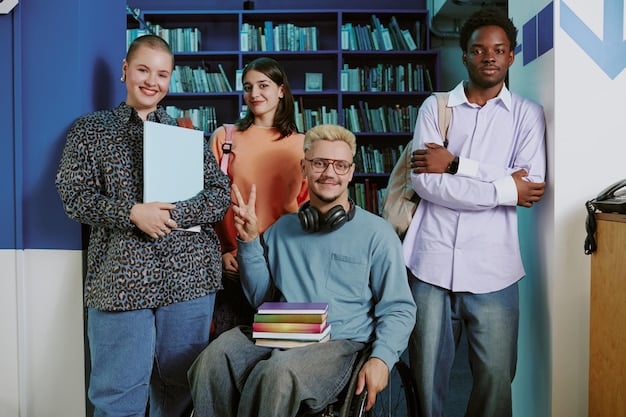Public Service Loan Forgiveness (PSLF): Are You on Track?

Public Service Loan Forgiveness (PSLF) offers debt relief to borrowers employed by qualifying organizations after making 120 qualifying payments, but navigating the requirements can be complex. This article helps you determine if you’re on track for PSLF.
Are you dedicating your career to public service and carrying the weight of student loans? The Public Service Loan Forgiveness (PSLF) program could be your path to financial freedom, but are you sure you’re on the right track?
Understanding the Public Service Loan Forgiveness (PSLF) Program
Navigating the complex world of student loan forgiveness can feel overwhelming. Let’s break down the fundamentals of the Public Service Loan Forgiveness (PSLF) program.
What is PSLF?
PSLF is a federal program designed to forgive the remaining balance on your Direct Loans after you’ve made 120 qualifying monthly payments while working full-time for a qualifying employer.
Who Qualifies for PSLF?
To be eligible for PSLF, you must be employed by a U.S. federal, state, local, or tribal government or a non-profit organization that is tax-exempt under Section 501(c)(3) of the Internal Revenue Code. Some other types of non-profit organizations may also qualify.
- Employment with qualifying employers is crucial.
- Only Direct Loans are eligible for forgiveness.
- Making 120 qualifying payments is a must.
- You need to be on a qualifying repayment plan.
The PSLF program has specific eligibility requirements. Failing to meet even one criteria can disqualify you from the program.
Qualifying Employment: Are You Working for the Right Employer?
Your employer is a crucial factor in determining your eligibility for the PSLF program. Understanding the qualifications for employment is essential.
Defining a Qualifying Employer
Qualifying employers include government organizations at any level (federal, state, local, or tribal) and certain non-profit organizations. For non-profits, the organization must be tax-exempt under Section 501(c)(3) of the Internal Revenue Code.
Part-Time vs. Full-Time Employment
You must be employed full-time, which is defined as working at least 30 hours per week or the number of hours the employer considers full-time, whichever is greater.

Employment status must meet the requirements of the program. Knowing this detail can greatly affect eligibility.
Eligible Loans: Which Loans are Eligible for Forgiveness?
Not all federal student loans qualify for PSLF. Understanding which loans are eligible is vital for staying on track.
Direct Loans: The Key to PSLF
Only loans received under the William D. Ford Federal Direct Loan Program are eligible for PSLF. This includes Direct Subsidized Loans, Direct Unsubsidized Loans, Direct PLUS Loans, and Direct Consolidation Loans.
Consolidating Non-Direct Loans
If you have loans that are not Direct Loans, such as Federal Family Education Loan (FFEL) Program loans or Perkins Loans, you can consolidate them into a Direct Consolidation Loan to make them eligible for PSLF.
- Only Direct Loans qualify for PSLF.
- Consolidate other federal loans into a Direct Loan.
- Ensure consolidation is done properly.
FFEL loans don’t qualify for PSLF unless consolidated into a Direct Loan. Failure to consolidate FFEL loans can result in the loss of PSLF eligibility.
Qualifying Payments: Making Sure Your Payments Count
Making 120 qualifying payments is a core requirement of PSLF. Understanding what constitutes a qualifying payment is essential for staying on track.
What is a Qualifying Payment?
A qualifying payment is a full, scheduled payment made no more than 15 days late while employed full-time by a qualifying employer. The payment must be made under a qualifying repayment plan.
Qualifying Repayment Plans
Qualifying repayment plans include income-driven repayment (IDR) plans such as Income-Based Repayment (IBR), Pay As You Earn (PAYE), Revised Pay As You Earn (REPAYE), and Income-Contingent Repayment (ICR). The 10-year Standard Repayment Plan also qualifies.

Understanding the ins and outs of qualifying payments is important.
The PSLF Application Process: Navigating the Paperwork
Applying for PSLF involves completing and submitting specific forms and documentation. Understanding the application process can streamline your path to forgiveness.
Submitting the PSLF Form
The PSLF form, officially known as the “Application for Public Service Loan Forgiveness,” must be submitted to the U.S. Department of Education. This form is used to certify your employment and track your qualifying payments.
The Employment Certification Form (ECF)
It’s highly recommended to submit the Employment Certification Form (ECF) annually or whenever you change employers. This helps to ensure that your employment qualifies for PSLF and provides an ongoing record of your progress.
- Submit the PSLF form after making 120 qualifying payments.
- Use the ECF annually to certify employment.
- Keep detailed records of all payments and employment.
Carefully documenting your progress through the PSLF process can help safeguard against errors or issues that may arise.
Common Pitfalls and How to Avoid Them
Navigating the PSLF program can be tricky, and there are several common mistakes borrowers make. Let’s explore these pitfalls and how to steer clear of them.
Incorrect Loan Types
Many borrowers mistakenly assume that all federal student loans are eligible for PSLF. FFEL loans and Perkins Loans do not qualify unless they are consolidated into a Direct Consolidation Loan.
Non-Qualifying Employment
Another common pitfall is working for an employer that is not considered a qualifying organization. Always verify your employer’s eligibility before assuming it qualifies.
- Ensure your loans are Direct Loans.
- Confirm your employer is a qualifying organization.
- Avoid late payments.
Staying informed can greatly reduce the risk of making mistakes in the PSLF application process.
Tracking Your Progress: Staying Informed and Organized
Keeping track of your payments, employment history, and loan information is crucial for staying on track with PSLF. Let’s explore some tips for effective tracking.
Maintaining Detailed Records
Keep copies of all loan documents, payment confirmations, employment certifications, and any correspondence with your loan servicer or the U.S. Department of Education. This documentation can be invaluable if any discrepancies or issues arise.
Using Online Tools and Resources
Utilize the online tools and resources provided by the U.S. Department of Education and your loan servicer. These resources can help you track your qualifying payments, monitor your loan progress, and stay informed about any program updates or changes.
Tracking your progress is an integral element. Being organized can help you succeed.
| Key Point | Brief Description |
|---|---|
| 🏢 Qualifying Employment | Work for a government or 501(c)(3) non-profit. |
| 💸 Eligible Loans | Direct Loans are required; consolidate others. |
| 📆 Qualifying Payments | 120 payments under an income-driven repayment plan. |
| 📝 PSLF Form | Submit the PSLF form annually to track progress. |
General FAQs
▼
Qualifying employers include government organizations at any level (federal, state, local, or tribal) and certain non-profit organizations that are tax-exempt under Section 501(c)(3) of the Internal Revenue Code.
▼
No, only loans received under the William D. Ford Federal Direct Loan Program are eligible. Other federal loans, such as FFEL loans, must be consolidated into a Direct Loan.
▼
A qualifying payment is a full, scheduled payment made no more than 15 days late while employed full-time by a qualifying employer and under a qualifying repayment plan.
▼
It is highly recommended to submit the ECF annually or whenever you change employers to ensure your employment qualifies for PSLF and to keep a record of your progress.
▼
Qualifying repayment plans include income-driven repayment (IDR) plans such as IBR, PAYE, REPAYE, and ICR, as well as the 10-year Standard Repayment Plan.
Conclusion
The Public Service Loan Forgiveness program offers a tremendous opportunity for those dedicated to public service. By understanding the eligibility requirements, meticulously tracking your progress, and avoiding common pitfalls, you can significantly increase your chances of having your student loans forgiven after 120 qualifying payments.





